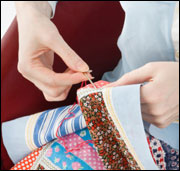Stitching it together
It would be easier to use a blanket, but we ask more of people who enter our churches: We ask them to be quilters.
It is sort of like trying to describe a quilt to someone who has not seen it, but may be familiar with the components: “Well it is a piece of that shirt, and bits from Micaela and Katy’s old dresses, with some green satin, and this floral print, and it all gets cut up into little pieces and then we stitch it back together.” Cut it up so you can just stitch it back together? Imagine that; quilting is so absurd when you think about it. We take perfectly good, beautiful, whole items, cut them up, and spend hours upon hours figuring out how to put them all back together. Quilters have got to be crazy!
Isn’t that a little bit like Unitarian Universalism? We are not a blanket. Blankets are good. Blankets keep us warm. Some blankets are beautiful as well as functional. But as a faith, Unitarian Universalists are not blankets. We are quilts. Taking bits of all that is out there—a little of this shirt, that dress, or this theology and that ritual—cutting it up, taking from it the parts that we find meaningful, inspirational, uniquely in sync with the core of our being, and we call those scraps our own. But you can’t leave your quilt in pieces. No, you have to then sew it all back together and make them a coherent whole.
It would be easier to use a blanket, and that may take care of many people’s needs. But we ask more of those who enter our churches. We ask them to be quilters, each and every one.
Some may say, “If you are just taking a little from here and there, cutting it up, piecing it together, and calling it your own, then you are fragmented and scattered, and possess only a fraction of what is out there and what could be called the Ultimate Truth.” And it is true. Being Unitarian Universalists, we do run the risk of cutting up our pieces and not putting them back together in a coherent whole, leaving ourselves fragmented, confused, and irrelevant. Which is why we have to stitch it all together and create our own quilt.
We all start with the same fabrics. We may take adult spiritual education and children’s religious education courses to help us understand all the fabric and creative elements that are out there. We find some of our fabric through spiritual practice, life experience, or personal religious history. We may find some fabric out there in the world as we notice issues of justice, peacemaking, and providing care and nurturance. Yet as anyone who is in a quilt guild like I am knows, even when you start with the same fabric, no two quilts will be alike. We all express our creativity and our spirituality differently, reflecting our own unique relationship to the sacred and divine.
During my time as minister of First Parish in Cambridge, Massachusetts, we were part of the Faith Quilts Project, an effort to nurture interfaith understanding in the wake of 9/11. In 2005, our group had the pleasure of going on a field trip to The Quilts of Gee’s Bend exhibit at the Museum of Fine Arts Boston. The quilters of Gee’s Bend live in a very rural and isolated community in Alabama. The residents are descendents of slaves and sharecroppers on the Pettway Plantation. For generations the women of Gee’s Bend have been quilting out of necessity, cutting up and preserving any bit of cloth they had to create quilts for warmth. These women learned to quilt at their mothers’ and grandmothers’ knees, and many were self-taught. They had no formal art training and very little education, yet the quilts they created were exquisite. Their quilts have received universal acclaim from art critics worldwide and have been compared to the works of artists such as Henri Matisse and Paul Klee.
The Faith Quilts Project hosted a dinner for the thirty or so quilters from Gee’s Bend who were in Boston for the opening of the show. It was a wonderful experience to meet these women and to learn of their creative inspiration. What was so striking about them was how inextricable their art was from their faith, spirituality, and relationship with the divine. As soon as we had all gathered and had our plates full of food, the quilters from Gee’s Bend broke out in gospel singing. They expressed their love and appreciation for us, our project, their welcome, as an articulation of their faith. Their quilting and their faith, their self-identity and their relationship with the holy, were all intimately interwoven.
Find the fabric that is most sacred and meaningful to you. Cut it up and then sew it back together in ways that are expressions of your faith. Be creative! Make it beautiful! Sing about it! Share it with all who will see. Then take a look at others’ quilts. Find out where they find the holy. Ask them questions, learn their story, and share yours with them. Become a “Piecemaker,” for we are all faith quilters.
This article appeared in the Fall 2012 issue of UU World. Adapted from a sermon preached March 19, 2006, at First Parish in Cambridge, Massachusetts. See sidebar for links to related resources.
Comments powered by Disqus







